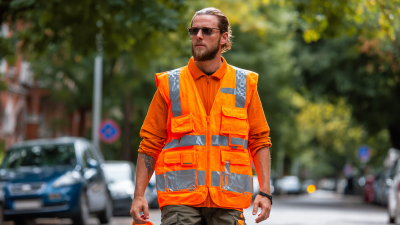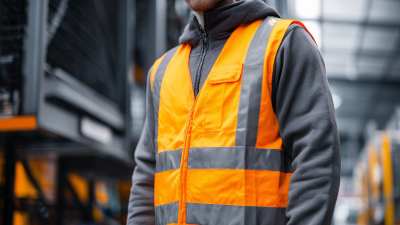In today's fast-paced world, ensuring safety during nighttime activities is paramount, especially for those who work or engage in outdoor pursuits after dark. One essential tool for enhancing visibility and preventing accidents is the Reflective Vest. These vests are designed with high-visibility materials that reflect light, making the wearer more noticeable to drivers and others in low-light conditions. This article will explore key tips on the effective use of Reflective Vests, illustrating their importance in various scenarios such as roadside work, cycling, and jogging. By prioritizing nighttime visibility through the use of Reflective Vests, individuals can significantly reduce the risks associated with poor lighting, ultimately fostering a safer environment for everyone. We will delve into crucial statistics about nighttime accidents and provide actionable tips to maximize the benefits of wearing these vital safety garments.

When it comes to nighttime safety, selecting the right reflective vest is crucial for ensuring maximum visibility. The first consideration should be the material of the vest. Look for vests made from high-visibility fabrics that are designed to reflect light efficiently. This not only enhances your visibility to drivers and cyclists but also provides a layer of protection in low-light environments. Additionally, ensure the vest includes reflective strips that are strategically placed to catch light from multiple angles.

Another important factor is the fit and design of the vest. A well-fitted vest should allow for freedom of movement while remaining comfortably snug. This is particularly important for individuals engaged in outdoor activities such as jogging or cycling. Opt for vests with adjustable straps or elastic materials to accommodate layering in different weather conditions. Lastly, consider the color of the vest; bright colors like fluorescent yellow or orange are highly visible during the day and provide added contrast in dimly lit areas, helping to make you stand out and stay safe.
When it comes to nighttime visibility, the type of reflective material used in safety vests can significantly impact the effectiveness of these garments. Reflective materials operate by returning light to its source, increasing the likelihood that a passerby or vehicle will see the individual wearing them. According to the National Institute for Occupational Safety and Health (NIOSH), high-visibility clothing with reflective materials can reduce the risk of accidents by as much as 50% in low-light conditions.
There are various types of reflective materials available, each serving different purposes. For instance, micro-prismatic retroreflective sheeting is particularly effective, as it reflects light from a wide range of angles, ensuring maximum visibility regardless of the observer’s position. This material is often used in professional-grade vests for road work and emergency responders. In contrast, glass bead reflective materials, while still useful, do not provide the same level of visibility and reflectivity, particularly in adverse weather conditions. Data from the American National Standards Institute (ANSI) suggests that vests made from higher-tier reflective materials meet more rigorous visibility standards and should be prioritized for those working in hazardous environments.
| Type of Reflective Material | Visibility Level | Common Uses | Durability |
|---|---|---|---|
| High-Visibility Retroreflective Material | Excellent | Construction, Road Work | High |
| Fluorescent Material | Good | Traffic Safety, Emergency Services | Moderate |
| Photoluminescent Materials | Fair | Emergency Signs, Pathway Marking | Low to Moderate |
| Reflective Tape | Good | Bicycle Safety, Vehicle Marking | Moderate |
| Beaded Retroreflective Material | High | Traffic Cones, Road Signs | High |
Wearing reflective vests is crucial for enhancing visibility during nighttime activities, and there are several best practices to maximize their effectiveness. First, it's essential to choose a high-visibility vest that meets safety standards, typically featuring bright colors and reflective strips. These elements not only increase your visibility to motorists but also ensure that you are seen from various angles, crucial for safety in low-light conditions.
When wearing a reflective vest, consider the fit and layering. The vest should be comfortable enough to allow movement while still being snug enough to avoid flapping in the wind. Additionally, pairing the vest with other reflective gear, such as wristbands or ankle straps, can further enhance your visibility. Always assess your environment; staying in well-lit areas and being aware of your surroundings is vital. By implementing these practices, you can significantly increase your safety during nighttime activities, whether walking, cycling, or engaging in other outdoor pursuits.

Wearing reflective vests significantly enhances nighttime visibility, but relying solely on them isn't enough for optimal safety. According to the National Highway Traffic Safety Administration (NHTSA), about 76% of pedestrian fatalities occur at night, highlighting the critical need for comprehensive safety gear. In addition to reflective vests, incorporating items such as tactical flashlights and glow sticks can dramatically improve visibility and safety. Flashlights with high lumens not only illuminate your path but also make you more visible to drivers, while glow sticks can offer an additional way to signal your presence in low-light conditions.
Moreover, it's essential to complement reflective gear with appropriate footwear and clothing. Research indicates that 60% of accidents happen due to a lack of traction, particularly in adverse weather conditions. Wearing shoes with slip-resistant soles, alongside moisture-wicking clothing and additional reflective accessories, can ensure stability and visibility. These added layers of safety gear can reduce the likelihood of accidents, making nighttime excursions safer for both workers and pedestrians alike. As the industry progresses, awareness around comprehensive safety gear will become increasingly vital in reducing nighttime incidents.
To ensure the longevity of your reflective vest, regular maintenance is key. It’s important to keep the vest clean and free from dirt and debris that could diminish its reflective properties. Most vests can be hand-washed with mild soap and water, but always check the care label for specific instructions. Avoid using harsh chemicals or fabric softeners, as these can affect the visibility of the reflective materials. After washing, allow the vest to air dry away from direct sunlight to prevent fading and degradation.
Additionally, proper storage of your reflective vest can extend its lifespan. Store it in a cool, dry place away from direct sunlight to protect the fabric from UV damage. Avoid folding the vest in a way that could crease or stress the reflective strips. Instead, consider hanging it on a hook or keeping it in a designated storage bag. By following these simple care tips, you can ensure your reflective vest remains effective and safe for nighttime visibility, providing you with protection for many years to come.






